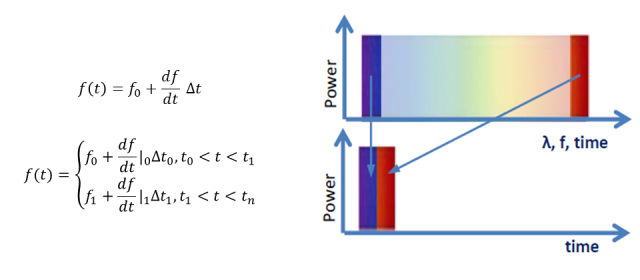Future-Proof Your System
Future-Proof Your System: Upcoming Capabiliites Based on Software-Controlled Sweep |
. . . Why New Capabilities Matter |
|---|---|
|
OCT is in its infancy; the future of OCT is very bright. There is considerable research into new methodologies (Doppler and polarization-sensitive OCT are just two of many) to exploit OCT to derive more information from the tissue. The flexibility afforded by a truly software-controlled laser may enable new insights and innovations that were not previously possible. |
The following capabilities will be available over the next several months. If you are interested, contact Insight Applications Engineering to be part of the rollout process for these new features. |
Adjustable Coherence |
|---|
|
With the Insight laser, you can tune the coherence length to your application. Set the coherence just above your imaging depth, and eliminate undesirable ghosting. There is ongoing research into the potential of using the Insight laser’s ability to interleave sweeps of differing coherence length to achieve advantageous image results, including the potential of speckle reduction and implementation of new analysis techniques. |
Noncontiguous Sweeps |
|---|
|
Because most of the information in an OCT sweep is contained in the first and last portions of the sweep, utilizing the data from only these sections of the sweep may unlock new potential for very fast OCT without needing to measure faster at lower resolution and reducing the data processing bottlenecks that can exist for high speed systems. Intriguingly, since the Insight laser can produce coherent sweeps in different bands (for example, 1310 linked to 1550), implementing non-continuous sweeps has the potential of creating a much wider effective sweep, substantially increasing the resolution. |
 |
Custom Wavelength Sweep Profile |
|---|
|
At the present time, the Insight laser can sweep in either linear-frequency, or linear-wavelength mode. Because the sweep profile is determined by software, there is no reason why the laser cannot sweep in a pre-determined non-linear wavelength- or frequency-versus-time profile. There are some researchers who are exploring this capability for new OCT capabilities. |
Simultaneous Multi-Wavelength Sweeps |
|---|
|
Because the Insight laser generates its own triggers and the wavelength is forced to be accurate at these equally spaced trigger points, there is now the opportunity to run simultaneous multi-wavelength sweeps. For example, two lasers may be linked to provide simultaneous 1310 nm and 1550 nm band sweeps. Since data from each of these bands provides different and complementary data for the image, combining the results from both bands can give physicians more and better diagnostic information. A single fiber optic probe can carry both wavelength bands simultaneously, but we can use either time delay multiplexing or wavelength division multiplexing to separate the bands for data acquisition. In a time delay multiplexing system, a single detector can be used to acquire both signals. Alternatively, in a wavelength division multiplexing system, dual-channel detection would be used. |
Adjustable Sweep Repetition Rate/Interlaced Sweep Rates |
|---|
|
Kinetic lasers have limited ability to change sweep rate. The sweep of the Insight laser can be changed at will, at any time. In fact, it may be possible to interlace sweeps of differing sweep rates. There is some contemplation in the OCT community that this could be used to beneficial effect. Sweep repetition rates can be varied by a factor of 20. |
Interlaced Forward and Backward Sweeps |
|---|
|
Probe movement is an issue for some OCT imaging applications. Providing interlaced forward and backward- linear-in-frequency sweeps can facilitate eliminating the effect of probe movement for certain applications. Unlike other lasers, the sweep linearity of the Insight laser - and the resulting PSF - are identical for forward or backward sweeps. |
Interlaced Number of Data Points |
|---|
|
The number of data points in a sweep can affect certain of the non-idealities in an image. The Insight laser opens the possibility to running interlaced sweeps with varying numbers of data points, and this could help researchers develop ways to reduce more of the non-idealities in an image. With an external k-clock this could be problematic, but it becomes easy with the Insight laser's internal electronic k-clock. |
Optical Auto-leveling |
|---|
|
The laser can auto-level the power profile across wavelength, and through internal measurement can automatically pre-emphasize the optical signal to compensate for wavelength and polarization dependent losses in the OCT interferometer, potentially improving the PSF and resulting image quality. |
User-Adjustable Coherence Length |
|---|
|
This upcoming function illustrates a unique characteristic of the Insight laser: It is a software platform for intricate, detailed control over a laser. One of the implications of this control is that the coherence length can be adjusted with software. If you only need 14 mm of coherence, the laser can be set for this. This capability can allow coherence length tuning to spurious reflections.
|



